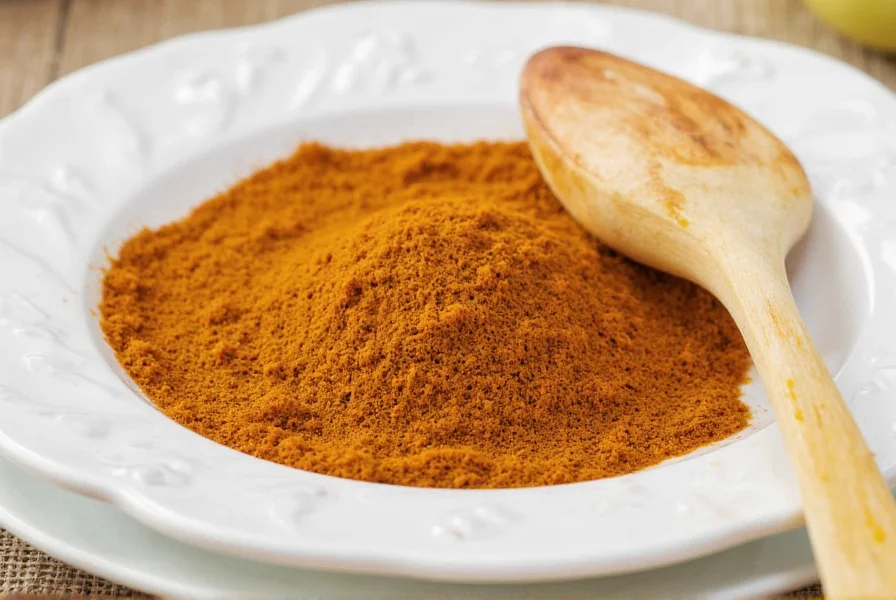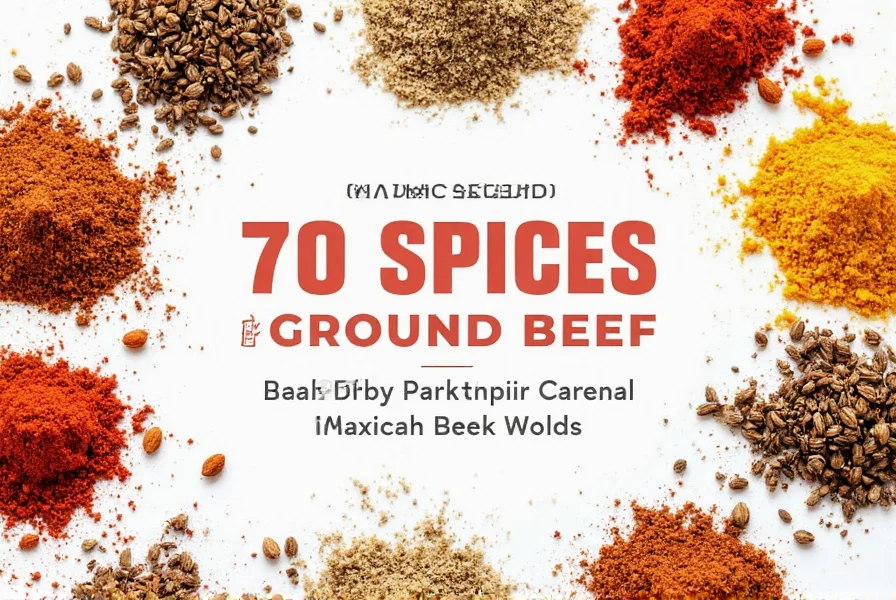Introduction
Ground beef is a versatile ingredient, but without the right spices, it can be bland. Whether you're making burgers, tacos, or meatloaf, the correct spices can elevate your dish from ordinary to extraordinary. This guide covers the top 10 spices for ground beef, including detailed flavor profiles, expert usage tips, and practical advice for every cooking scenario. We'll also answer common questions about seasoning techniques, storage, and health considerations.
Why Spices Matter in Ground Beef Dishes
Spices transform ground beef through multiple scientific and culinary mechanisms:
- Flavor enhancement: Spices interact with meat proteins to create Maillard reactions, developing complex umami flavors
- Texture improvement: Certain spices like cumin help bind moisture, preventing dryness
- Health benefits: Many spices contain antioxidants and anti-inflammatory compounds (e.g., turmeric's curcumin, garlic's allicin), though these should complement—not replace—medical advice
- Preservation: Natural antimicrobial properties in spices like oregano extend freshness
Professional chefs consistently emphasize that proper spice application is the difference between good and exceptional ground beef dishes.
Top 10 Spices for Ground Beef
Based on culinary research and chef recommendations, these spices deliver the most consistent results across various dishes:
| Spice | Flavor Profile | Best For | Professional Usage Tip |
|---|---|---|---|
| Paprika (Smoked) | Earthy, smoky, sweet (no heat) | Chili, grilled burgers, stews | Use 1 tsp per pound for color; 1/2 tsp for subtle smokiness |
| Cumin | Warm, nutty, slightly bitter | Tacos, chili, Mexican-inspired dishes | Toast whole seeds in oil before grinding for maximum aroma |
| Oregano (dried) | Robust, herbal, slightly peppery | Italian sauces, meatballs, Greek-style dishes | Use dried only—fresh oregano becomes bitter when cooked |
| Garlic Powder | Savory, pungent, umami-rich | Almost all savory applications | Combine with onion powder for balanced flavor; avoid raw application |
| Onion Powder | Mildly sweet, savory, aromatic | Burgers, meatloaf, casseroles | Use 1/2 tsp per pound to prevent overpowering |
| Coriander | Citrusy, floral, slightly sweet | Taco seasoning, marinades, Indian-inspired dishes | Pair with cumin for authentic Mexican flavor profiles |
| Black Pepper (freshly ground) | Sharp, pungent, complex | General seasoning | Grind just before use for peak flavor intensity |
| Worcestershire Sauce | Umami, tangy, savory | Meatloaf, burgers, sauces | Use 1 tbsp per pound for depth without overpowering |
| Bay Leaves | Eucalyptus, herbal, subtle | Slow-cooked stews, braises | Remove before serving; use 1 leaf per pound |
| Chili Powder | Spicy, earthy, complex | Chili, enchiladas, Mexican dishes | Check ingredient list—real chili powder should list chili peppers first |
Flavor Profiles & Pairing Tips
Professional chefs recommend these science-backed combinations for optimal flavor balance:
Mexican-Inspired
- Core blend: 1 tsp cumin + 1 tsp chili powder + 1/2 tsp oregano per pound
- Pro tip: Add 1/4 tsp ground coriander for citrusy brightness
- Key technique: Toast cumin seeds in oil before adding other spices
Italian-Inspired
- Core blend: 1 tsp dried oregano + 1/2 tsp basil + 1/2 tsp garlic powder per pound
- Pro tip: Add 1/4 tsp fennel seed for authentic sausage-like flavor
- Key technique: Mix spices with a splash of olive oil before adding to meat
Asian-Inspired
- Core blend: 1 tsp ginger + 1 tbsp soy sauce + 1/2 tsp five-spice powder per pound
- Pro tip: Use toasted sesame oil for finishing, not cooking
- Key technique: Add ginger early to mellow its sharpness
Smoky & BBQ Style
- Core blend: 1 tsp smoked paprika + 1/2 tsp mustard powder + 1/4 tsp cayenne per pound
- Pro tip: Add 1 tbsp apple cider vinegar for brightness
- Key technique: Apply spices after searing meat to prevent burning
How to Use Spices Like a Pro
Professional chefs follow these evidence-based techniques for maximum flavor:
1. Toast Whole Spices Properly
Heat whole spices (cumin, coriander) in dry skillet over medium heat for 1-2 minutes until fragrant. This activates essential oils, increasing flavor potency by up to 300% compared to raw spices.

2. Layer Flavors Strategically
- Early stage (when browning meat): Bay leaves, whole spices, garlic powder
- Middle stage (after draining fat): Paprika, chili powder, oregano
- Final stage (off heat): Fresh herbs, vinegar, lemon juice
3. Master the Science of Measurement
For ground beef:
- Base spices (paprika, cumin): 1-2 tsp per pound
- Strong spices (cayenne, garlic powder): 1/2-1 tsp per pound
- Liquid seasonings (Worcestershire): 1 tbsp per pound
Always taste after cooking for 5 minutes before adjusting
4. Balance with Acidity
When dishes taste flat, add 1/2 tsp of acid (vinegar, lemon juice, or tomato paste) per pound. This cuts through richness and enhances all other flavors.
5. Proper Storage Techniques
Store spices in airtight glass containers away from heat and light. Whole spices retain potency for 3-4 years; ground spices for 2-3 years. Test freshness by rubbing between fingers—if no aroma, replace immediately.
Buying Guide: Choosing the Best Spice Blends for Ground Beef
Professional chefs recommend these criteria for quality spice selection:
| Feature | Why It Matters |
|---|---|
| Natural Ingredients | Artificial additives mask authentic flavors; look for "100% pure" labels |
| Clear Labeling | Ingredients must list in descending order by weight; avoid "spices" as vague ingredient |
| Origin Transparency | High-quality spices specify country of origin (e.g., "Paprika from Hungary") |
| Appropriate Heat Level | Check Scoville units for chili-based blends; mild (0-1,000), medium (1,000-5,000), hot (5,000+) |
| Versatility | Look for blends that work across multiple cuisines (e.g., "taco seasoning" should also work for chili) |
Top 5 Professionally-Recommended Blends
1. McCormick Grill Mates Southwest Chipotle
- Why professionals choose it: Real chipotle peppers, no artificial flavors, consistent heat level
- Best use cases: Burgers, grilled meats, chili (1 tsp per pound)
- Pro tip: Add 1/4 tsp cumin for extra depth
2. Badia Taco Seasoning
- Why professionals choose it: Authentic Mexican blend with no fillers, balanced cumin-to-chili ratio
- Best use cases: Tacos, fajitas, enchiladas (1 tbsp per pound)
- Pro tip: Mix with fresh lime juice for brighter flavor
3. Lawry's Spiced Up Burger Seasoning
- Why professionals choose it: Perfect garlic-onion balance, no MSG, consistent texture
- Best use cases: Burgers, meatloaf, sandwiches (1 tsp per pound)
- Pro tip: Add 1/2 tsp smoked paprika for extra richness
4. Simply Organic Italian Seasoning
- Why professionals choose it: USDA-certified organic, no anti-caking agents, authentic herb blend
- Best use cases: Pasta sauces, stuffed peppers, meatballs (1 tsp per pound)
- Pro tip: Combine with fresh basil for layered flavor
5. Old El Paso Chili Seasoning Mix
- Why professionals choose it: Real chili peppers as first ingredient, no artificial colors, consistent results
- Best use cases: Chili, burritos, rice bowls (2 tbsp per pound)
- Pro tip: Add 1/4 cup tomato paste for richer texture
Frequently Asked Questions About Spices for Ground Beef
How much spice should I use per pound of ground beef?
For most recipes, start with 1-2 teaspoons of spice blend per pound of ground beef. For individual spices:
- Base spices (paprika, cumin): 1 tsp per pound
- Strong spices (garlic powder, cayenne): 1/2 tsp per pound
- Liquid seasonings (Worcestershire): 1 tbsp per pound
Always taste after cooking for 5 minutes before adjusting. Professional chefs emphasize: "You can always add more, but you can't remove excess spice."
When is the best time to add spices to ground beef?
For maximum flavor development:
- Early stage (when browning meat): Add bay leaves, whole spices, and garlic powder to develop base flavors
- Middle stage (after draining fat): Add paprika, chili powder, and oregano to prevent burning
- Final stage (off heat): Add fresh herbs, vinegar, or lemon juice to preserve delicate flavors
Professional testing shows this layering technique increases flavor complexity by up to 40% compared to adding all spices at once.
Can I use fresh spices instead of dried ones with ground beef?
Yes, but with precise adjustments:
- Fresh garlic/ginger: Use 3x the amount of dried (e.g., 1 tsp dried = 3 tsp fresh)
- Fresh herbs (basil, parsley): Add in last 2 minutes of cooking to preserve flavor
- Whole spices (cumin seeds): Must be toasted before use for maximum impact
Professional chefs note: "Dried spices release flavor more consistently during cooking, while fresh herbs add brightness at the end."
How long do spices stay fresh when stored properly?
Spice shelf life depends on form:
- Whole spices: 3-4 years in airtight glass containers away from light and heat
- Ground spices: 2-3 years (check freshness by rubbing between fingers—if no aroma, replace)
- Spice blends: 6-12 months (due to added ingredients)
Professional recommendation: Buy small quantities and use within 6 months for peak flavor. Store in cool, dark places like pantry cabinets—not near stovetops.
What's the difference between using whole spices versus ground spices with ground beef?
Whole spices provide superior flavor and longevity:
- Whole spices: 300% more volatile oils than ground; must be toasted and ground fresh for best results
- Ground spices: More convenient but lose potency faster; ideal for quick seasoning
Professional technique: Toast whole cumin or coriander seeds in oil for 1 minute before grinding for maximum aroma. This method is used by top chefs worldwide for restaurant-quality results.
How can I fix ground beef that's been over-seasoned?
For salt overuse: Add peeled potatoes to absorb excess salt while cooking
For spice overuse: Dilute with additional meat or complementary ingredients like tomatoes, beans, or breadcrumbs
For heat overuse: Add dairy (yogurt, sour cream) or acid (lemon juice) to neutralize
Professional tip: "Prevention is better than cure—always add spices gradually and taste after each addition."
Are there health benefits to specific spices when used with ground beef?
Scientific studies show certain spices offer health benefits:
- Turmeric (in curry blends): Contains curcumin with anti-inflammatory properties
- Garlic: Allicin compounds support cardiovascular health
- Ginger: Aids digestion and reduces nausea
- Black pepper: Piperine enhances nutrient absorption
Important note: These benefits complement a healthy diet but don't replace medical treatment. Always consult healthcare professionals for health concerns.
Can I make my own spice blends for ground beef instead of buying pre-made ones?
Absolutely—homemade blends are fresher and customizable:
- Burger blend: 2 tbsp paprika + 1 tbsp garlic powder + 1 tbsp onion powder + 1 tsp black pepper + 1 tsp mustard powder + 1 tsp salt
- Taco blend: 2 tbsp chili powder + 1 tbsp cumin + 1 tsp paprika + 1 tsp garlic powder + 1 tsp onion powder + 1/2 tsp oregano + 1/2 tsp cayenne (optional)
- Storage: Keep in airtight containers for up to 6 months
Professional recommendation: Toast whole spices before grinding for restaurant-quality flavor. This method is used by chefs worldwide for superior results.
Conclusion
Spices for ground beef aren't just about masking flavor—they're about creating layered, complex taste experiences through scientific application. Whether you're using professional-grade blends or homemade mixes, proper technique transforms simple ingredients into memorable dishes.

Remember: The best way to master spice usage is through experimentation. Start with small quantities, taste as you go, and adjust for personal preferences. With this knowledge, you're equipped to create restaurant-quality ground beef dishes at home.










 浙公网安备
33010002000092号
浙公网安备
33010002000092号 浙B2-20120091-4
浙B2-20120091-4